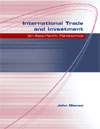|
 |  International Trade and Investment John Gionea,
RMIT
Features
Student Friendly Features Include:
- Case studies: Each chapter (except chapter 11) ends with a comprehensive case study, allowing the learner to view theory in a real life environment.
- Learning Objectives: Each chapter opener clearly states discussion topics and aims.
- Introduction: Checklists enable the student to track their learning as they go.
- Living application: Real data and statistics are used throughout the text.
- Chapter Summary: For the reader to review key points covered in the chapter, ensuring they have an understanding of the chapter's objectives. Particularly useful for revision.
- Review Questions and Applied Exercises: A final chance for students to assess their learning.
- Key Terms: Providing students all of the key words they need to understand within each chapter.
Key Features of International Trade and Investment include:
- Statistical Methods: Statistical methods for the assessment of the degree of globalisation of an economy (e.g. trend rates, the intra-industry trade index, the Hirschman concentration index etc.), especially concentrated in Chapters 1 to 3.
- Real Statistics: Extensive comparative international statistics on international trade and investment and on Australia's positions in trade and investment in various regions and countries of the world.
- Incoterms: A detailed and applied presentation of the Incoterms 2000(Chapter 13).
- Real Data: Comparable data on advertising expenditure per head and by medium in over 25 countries (Chapters 14 to 16) as well as comparative data about the major exporters in Australia and Canada, two resource-rich economies (Chapter 13).
- Practical: A practical country investment evaluation method, which can be used in student research projects and in the business practice. (Chapter 12).
- Terminology: A Glossary of Terms and a List of Acronyms are provided in this text.
- References: A rich list of references, including Internet site addresses or links to data sources, information and analysis on international trade and investment.
|
|
|



 2003 McGraw-Hill Higher Education
2003 McGraw-Hill Higher Education

 2003 McGraw-Hill Higher Education
2003 McGraw-Hill Higher Education